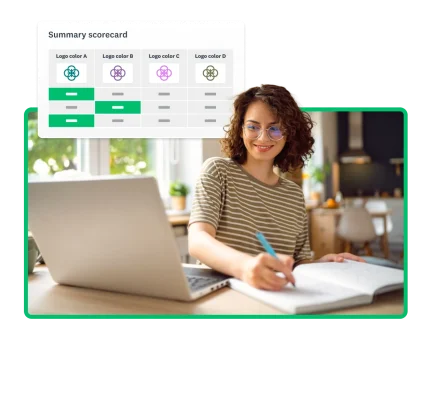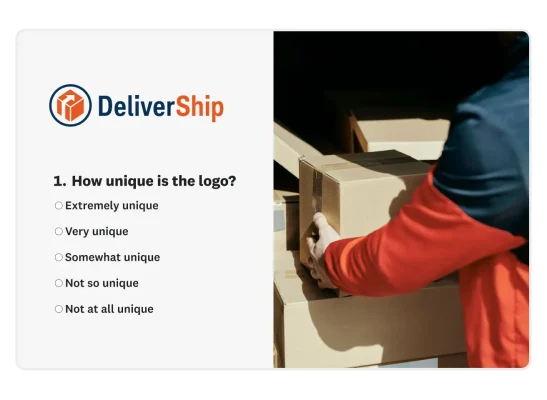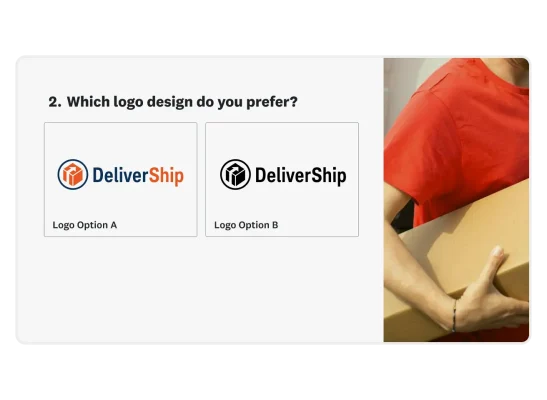Logo testing: how to analyze, evaluate, and perfect your logo
The essential steps for effective logo testing to ensure your design resonates with your audience. Read on to refine your brand's identity.

Whether you’re launching a new business or rebranding an existing one, selecting the right logo is one of the most important branding decisions you’ll make. Don’t leave such an important decision up to chance. See what works and what doesn’t by performing logo testing.
What is logo testing?
Logo design testing places different designs in front of your target market to gauge their effectiveness. It measures specific metrics like appeal and uniqueness, empowering you to select a design that will succeed in the real world.
This design process transforms a subjective decision into one backed by concrete research. When you test multiple logos through well-designed surveys, you uncover surprising insights about how consumers perceive your brand visually.
Use our Logo Testing Survey template to streamline the design process.
Why should you test your logo?
A good logo is one of the most important brand differentiators. Major companies invest significant resources in logo design because they understand its impact on consumer perception and purchase intent.
Logo testing provides four key advantages:
- They give you concrete data to support your decisions.
When you can show which design resonates most with your target audience, it's easier to justify your choice and get buy-in from stakeholders. - Surveys highlight areas for improvements.
Even your top-performing logo might have elements that could be enhanced, like color scheme or typography. Respondents often provide unexpected insights that can take your design from good to exceptional. - You'll learn how different segments of your audience respond to each design.
This helps you create a logo that appeals specifically to your ideal customers. What appeals to one demographic might fall flat with another, and testing helps you navigate these differences effectively. - Logo testing surveys let you iterate quickly.
By concept testing, you can refine your designs based on actual data rather than assumptions. This agile approach to logo development helps you arrive at the most effective design with minimum wasted effort.
When should you test your logo idea?
Test your logo at these critical stages:
- During initial design development to understand which concepts resonate before investing too much in any direction.
- When choosing between final logo candidates to see which performs best across key metrics.
- Before finalizing your winning design to identify any issues or opportunities for refinement.
- When rebranding to measure how your new logo compares to your existing one in brand recognition.
- When entering new markets, especially international ones, cultural differences can dramatically affect perception.

How to conduct logo testing
Now that you know why it’s important to evaluate your logo ideas before coming to a decision, let's start testing them with these four steps:
1. Define your testing goals
Determine exactly what you want to learn. Are you comparing multiple logos for appeal? Measuring how well the logo design aligns with your brand? Testing what makes a logo memorable to your target demographic?
Clear objectives help you create focused questions and collect actionable data from your market research.
2. Define your target audience
Gather feedback from a representative sample of your intended audience to find out if your logo resonates. Define participants based on demographics that match your target demographic rather than collecting general opinions.
3. Use the right testing methods
Combine these effective market research approaches:
- A/B testing to compare different logo designs (Pro-Tip: Ensure your results are statistically significant with our A/B testing calculator)
- Recognition testing to identify factors that make a logo memorable enough to stand out
- Scalability testing across different mediums (websites, business cards, etc.)
- Emotional response assessment through focus group discussions
- Competitive analysis to ensure your logo design stands out

4. Analyze and iterate
Even after you've built and shared out your final design, you'll want to keep the design process going to make targeted improvements using feedback as your brand image and market conditions change.
Consider multiple testing rounds for important logo decisions, with each iteration addressing specific issues from previous feedback. For the most comprehensive results, combine survey data with insights from focus group sessions.
Logo testing survey questions to ask
A comprehensive logo testing survey should include questions that cover these key areas:
- Which logo do you prefer, and why?
- Does this logo align with our brand values?
- How memorable is this logo?
- Do the design elements feel appropriate for its industry?
- What personality traits would you associate with a brand using this logo?
- How likely would you be to purchase from a company with this logo?
Remember to balance closed-ended questions (ratings, scales, multiple choice) with open-ended ones that allow respondents to explain their reactions in their own words. This combination provides both quantifiable data and rich qualitative insights. You can use our premade template filled with logo-testing survey questions to streamline your logo-testing process.
Related: How logo designs impact brand trust
How to evaluate a logo
When analyzing your logo testing results, the following criteria will help you understand what makes a good logo:
Alignment with brand identity
The most effective logos accurately reflect your brand's personality and values. Look for feedback that confirms your design communicates the right message to your audience.
A logo design should serve as a visual shorthand for your brand's core identity. If survey respondents associate your logo concepts with attributes that don't align with your brand positioning, this suggests a disconnect that needs addressing.
Memorability and recognition
A successful logo sticks in people's minds. Your survey should measure how recognizable your design is to respondents—a key indicator of its long-term effectiveness.
The most recognizable logos typically feature a distinctive element that separates them from competitors. Your research should help identify which aspects of your design are most memorable and distinctive.
Simplicity and clarity
Logos that try to say too much often end up saying nothing at all. Survey feedback should confirm that consumers understand what your logo represents without lengthy explanations.
Simplicity doesn't mean boring—it means communicating efficiently with minimal visual elements. The best logos convey complex brand messages through elegantly simple designs.
Versatility across mediums
Your logo needs to work everywhere your brand appears. Use your survey to test how it performs across different applications and contexts.
A versatile logo maintains its impact, whether it's on a billboard, business card, or mobile phone. Show respondents your design in multiple contexts and get feedback on how well it translates across different sizes and media.
Uniqueness and differentiation
Your logo should stand out from competitors. Survey responses should indicate that your design is distinctive within your industry.
Distinctiveness exists on a spectrum—too similar to competitors and your brand gets lost; too different and you might seem out of place in your category. Your research should help you focus on the right balance.
Consider showing respondents your logo alongside competitors' designs and asking which one they would remember most easily. This direct comparison helps assess your design's standout quality.
Effective use of colors and typography
Color psychology plays a significant role in how logos are perceived. Survey data should confirm your color choices evoke the right associations and emotional responses.
Typography similarly communicates personality—serif fonts often convey tradition and reliability, while sans-serif styles can appear more modern and approachable. Feedback should validate that your font choices align with your brand character.
Best practices for logo testing
Follow these guidelines to get the most reliable results from your logo testing survey:
- Define clear testing objectives
- Use both qualitative and quantitative questions
- Ensure your respondent pool accurately represents your target audience
- Test multiple logos across different backgrounds and formats
- Compare against competitor logos
- Present options in randomized order to prevent sequence bias
- Analyze emotional responses alongside rational assessments
- Use results to guide iterative improvements
Remember that logo testing is an investment that pays dividends throughout your brand's lifecycle. The upfront cost of thorough research prevents the much larger expense of launching an ineffective logo or having to rebrand again prematurely.
Test your logo ideas with SurveyMonkey
Selecting the right logo is too important to leave to chance. SurveyMonkey makes it easy to create professional logo testing surveys in minutes. Our specialized templates include expert-crafted questions that cover all the essential aspects of logo evaluation. And with powerful analysis tools, you can interpret results quickly and clearly.
Use our resources to create a logo testing survey today.
Discover more resources

Understand your target market to fuel explosive brand growth
Brand marketing managers can use this toolkit to understand your target audience, grow your brand, and prove ROI.

Hornblower enhances global customer experiences
Discover how Hornblower uses SurveyMonkey and powerful AI to make the most of NPS data, collect customer insights, and improve customer experiences.

Marketing trends: 3 strategies to stay relevant and ready for what's next
New SurveyMonkey research reveals critical insights on the state of marketing. Discover marketing trends to fuel your strategies and stay relevant.

8 marketing trends in 2025: consumer perspectives on AI and social media
Get insights on how AI and social media marketing activities impact consumer buying decisions in our new marketing trends report